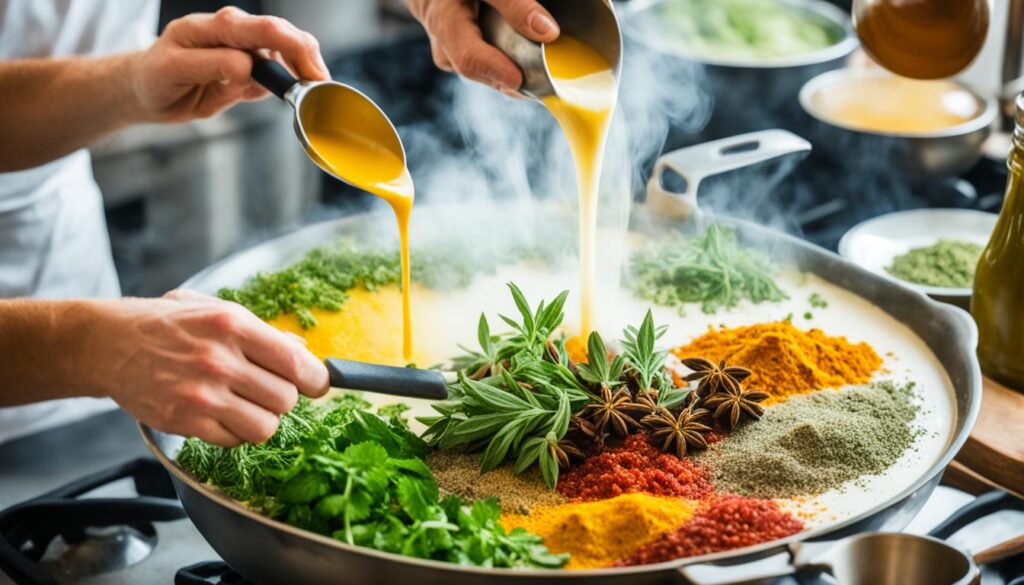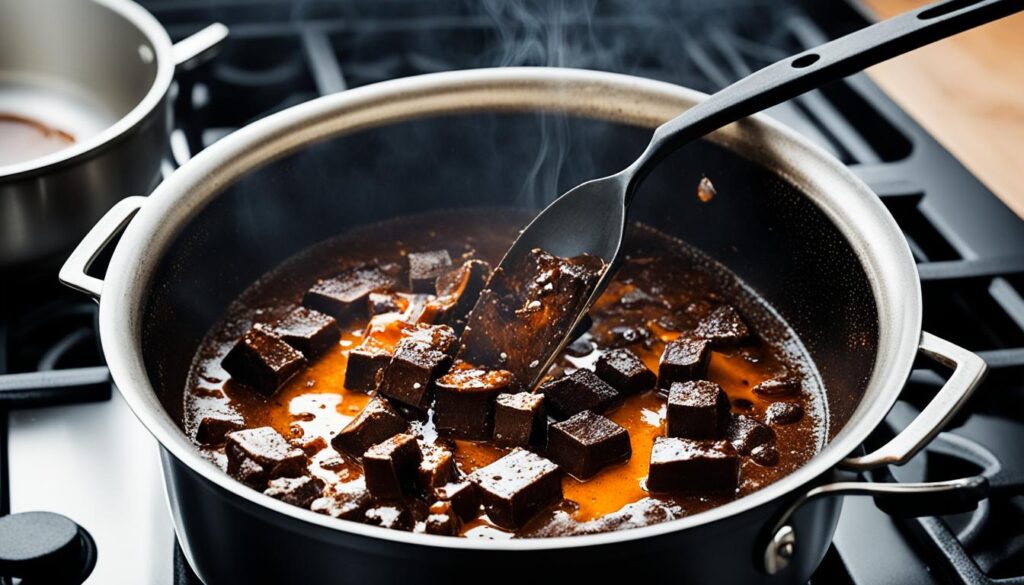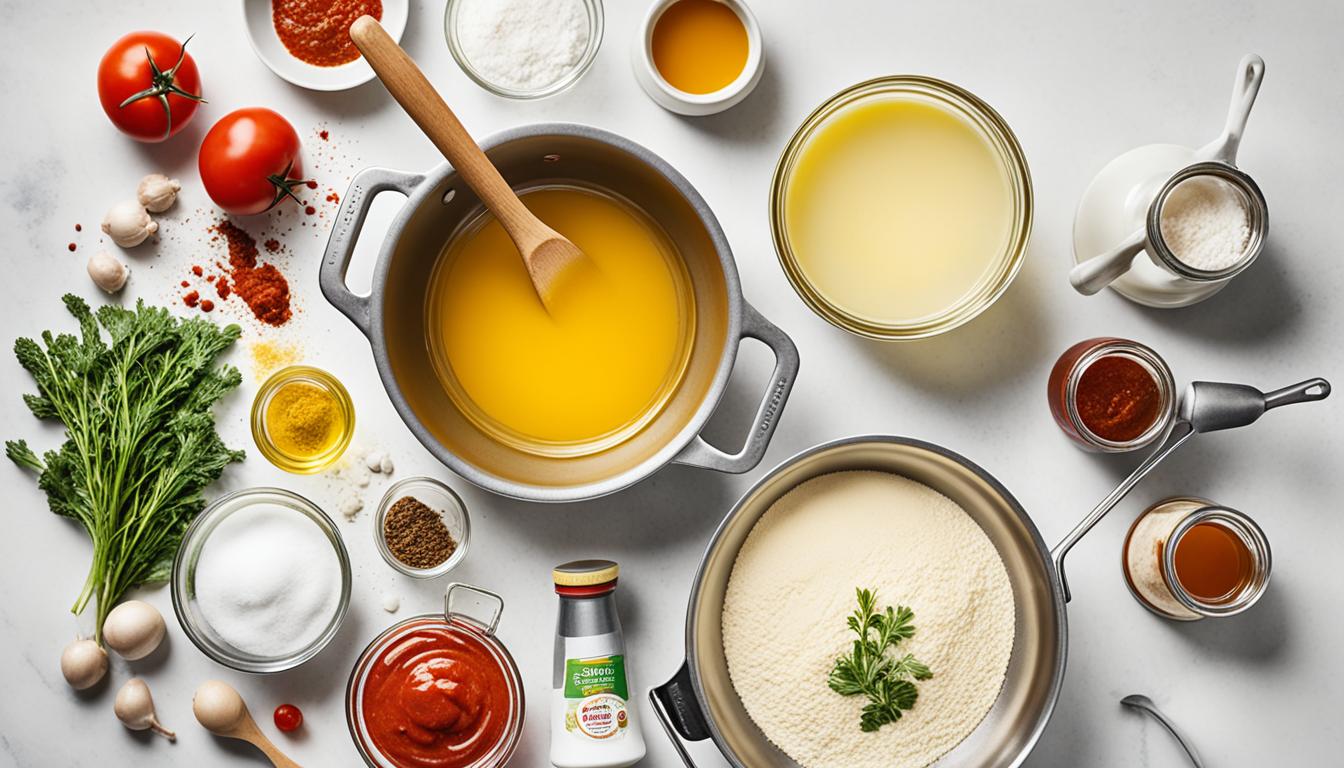Have you ever experienced the frustration of a broken sauce ruining your culinary masterpiece? You pour time and effort into creating a delicious sauce, only to have it separate into a watery mess. But fear not! We’re here to share our top sauce repair tips and quick restoration methods to help you salvage even the most broken sauces.
Whether you’re a novice cook or a seasoned chef, knowing how to fix a broken sauce is a valuable skill that can save your dish. From troubleshooting common sauce problems to preventing breakage in the first place, we’ll guide you through the process so you can rescue your sauces and elevate your cooking to new heights.
So, are you ready to unlock the secrets of sauce repair? Let’s dive in and discover how to bring your broken sauces back to life!
Why Do Sauces Break?
Sauces can break for several reasons, requiring troubleshooting and repairs to fix common sauce problems at home. Understanding the causes behind sauce breakage is crucial for preventing and rectifying these issues.
One common factor that can lead to a broken sauce is cooking at high heat. Exposing the sauce to excessive heat can cause the fat and water to separate, resulting in an undesirable texture and appearance. Adding too much liquid to a hot pan can also contribute to sauce breakage. The sudden addition of liquid can cause the emulsion to break, leading to separation of the ingredients.
Another reason sauces may break is when the ingredients are not properly combined. Waiting too long for the ingredients to incorporate can result in an unstable emulsion, causing the sauce to break. It is crucial to mix the ingredients together in a timely manner to prevent the fat and water from separating.
When a sauce breaks, it manifests as an oily mess with the fat or water separating from the other solvents. This can ruin the texture, appearance, and taste of the sauce. Troubleshooting broken sauces and repairing them at home is essential for salvaging your culinary creations.
Stay tuned for the next section on how to prevent sauce breakage and maintain the perfect consistency in your culinary creations.
How to Prevent Sauce Breakage
Preventing sauce breakage is essential for maintaining the perfect consistency and texture of your culinary creations. By following a few simple techniques, you can minimize the risk of sauce separation and ensure a smooth and delicious outcome. Here are some DIY sauce repair techniques that can help you prevent sauce breakage:
- Cook sauces at the right temperature: Proper heat control is crucial to prevent sauce breakage. Avoid cooking sauces at high temperatures, as this can cause the fat and liquid to separate. Instead, cook sauces over gentle heat, allowing the ingredients to meld together gradually.
- Add ingredients in the correct order: The order in which you add ingredients can affect the stability of your sauce. When making cream sauces, it’s best to add herbs, spices, and other flavorings before adding cream. This ensures that the cream blends smoothly with the other ingredients, reducing the risk of breakage.
- Mix water first, then add emulsifiers: If your sauce requires emulsifiers like eggs or mustard, it’s helpful to mix them with water before incorporating them into the sauce. This step promotes a stable emulsion, making it less prone to breaking.
- Blend or whisk the sauce while cooking: To maintain a stable emulsion, consider using a blender or whisk to continuously mix the sauce as it cooks. This gentle agitation helps to evenly distribute the fats and other components, preventing separation.
By incorporating these preventative measures into your sauce-making process, you can significantly reduce the chances of encountering sauce breakage. Taking these small but effective steps will help ensure that your sauces stay perfectly emulsified, enhancing the overall taste and presentation of your dishes.
How to Fix a Partially Broken Sauce
When a sauce breaks during cooking, it can be a frustrating setback. However, there are simple methods to fix a partially broken sauce and restore its emulsion.
- Add more liquid: The first step in fixing a partially broken sauce is to add more liquid. The amount of liquid to add depends on the extent of the breakage. For a partially broken sauce, adding half the amount of oil that caused the breakage should help restore the emulsion.
- Choose the right liquid: Stock, wine, water, butter, or cream can be used as additional liquid to bring the sauce back together. The choice of liquid depends on the flavor profile of the sauce and the desired consistency.
- Whisk or blend: Whisking or blending the sauce after adding the liquid helps to incorporate it evenly and aids in the emulsification process. The action of whisking or blending helps the fat and liquid to come together again, resulting in a smoother sauce.
To illustrate the process, here’s an image of a chef fixing a partially broken sauce:

By following these steps, you can rescue your partially broken sauce and continue creating delicious culinary masterpieces.
How to Fix a Completely Broken Sauce
If a sauce is completely broken, it requires a bit more effort to fix. But don’t worry, we have a solution! Using a blender is an effective method for restoring a broken sauce to its smooth and creamy consistency. Here’s how you can do it:
-
Pour the broken sauce into a blender.
-
Blend the sauce until it becomes smooth and emulsified.
-
If a blender is not available, you can try whisking in an ice cube or vigorously blending the sauce using a whisk in a bowl.
-
After blending, gently heat the sauce on the stove to maintain the stability of the emulsion.
By following these steps, you can fix a completely broken sauce and salvage your culinary creation. Remember, a blender can be your best friend when it comes to restoring sauces to their desired consistency.
Next, we’ll explore different thickening agents you can use to stabilize and revive a broken sauce. Stay tuned!
Thickening Agents for Broken Sauces
When a sauce breaks and the emulsion is compromised, adding thickening agents can help stabilize the sauce and bring it back together. Here are some effective thickening agents you can use to rescue your broken sauces:
1. Egg Yolk
In white sauces, such as hollandaise or béarnaise, adding an egg yolk can act as a natural thickening agent. The proteins in the egg yolk help bind the emulsion, restoring the sauce’s consistency and ensuring a smooth texture.
2. Heavy Cream
For tomato-based sauces, incorporating heavy cream is an excellent way to bind the oil with the tomatoes. The richness and fat content of the cream contribute to stabilizing the emulsion and achieving a velvety texture.
3. Cornstarch
Cornstarch dissolved in water can be used to thicken and stabilize a broken sauce. Create a slurry by mixing equal parts cornstarch and water, then slowly add the slurry to the sauce while whisking continuously. This method helps restore the emulsion and thickens the sauce.
4. Roux
Another technique to thicken and stabilize a broken sauce is by making a roux. Cook equal parts flour and fat, such as butter, in a saucepan until it forms a paste. Then gradually add the roux to the broken sauce, stirring continuously until the desired consistency is achieved.
Remember to add the thickening agent slowly and blend thoroughly to ensure a smooth and cohesive sauce. Experiment with these thickening agents to rescue broken sauces and stabilize the emulsion, bringing your dishes back to their delicious glory.
Tips to Fix Curdled Sauces
Curdling occurs when the proteins in a sauce denature and separate from the water, resulting in the formation of curds. Dealing with curdled sauces can be challenging, but there are strategies that can help restore them to their desired consistency.
When you encounter a curdled sauce, the first step is to halt the cooking process. This can prevent further separation and give you a chance to rescue the sauce. Adding a small amount of liquid, such as water or stock, to the curdled sauce can help dilute the curds and make it easier to bring the sauce back together.
Whisking vigorously is another technique that can aid in returning the proteins to their original state. This action helps in re-establishing the emulsion and smoothing out the texture of the sauce.
Another method to fix a curdled sauce is to gradually incorporate the broken sauce into a mixture of egg yolk and liquid. The egg yolk acts as a stabilizer and aids in forming a fresh emulsion. This process must be done gradually to ensure a smooth transition and prevent further curdling.
To further stabilize a curdled sauce, you can add a tablespoon of heavy cream. The fat content in the cream helps bind the sauce back together and provides a smoother consistency.
Remember, curdled sauces can be challenging to fix, but with these tips and techniques, you can potentially salvage your sauce and avoid starting over. It’s always recommended to exercise caution and gradually apply the remedies to prevent further complications. By understanding how curdling occurs and implementing these strategies, you’ll have a better chance of successfully restoring your sauce.
Why Do Curdled Sauces Happen?
Curdling in sauces, especially dairy or egg-based sauces, can occur due to various factors. Understanding these reasons can help in preventing curdling and maintaining a smooth and creamy consistency in sauces.
Insufficient Fat
Not having enough fat in the sauce can lead to curdling. Fat helps stabilize the emulsion and prevent the proteins from denaturing and separating from water.
High Heat
Cooking sauces at high heat can cause the proteins in dairy or egg-based sauces to denature and separate. It is important to control the heat and cook the sauce at a moderate temperature to avoid curdling.
Acidic Ingredients
The addition of acid, such as lemon juice or vinegar, to a sauce can cause curdling. Acidic ingredients disrupt the protein structure and contribute to the separation of proteins from water.
Addition of Dairy or Egg Yolks Too Quickly
Adding dairy or egg yolks too quickly to a hot sauce can result in curdling. Slowly incorporating these ingredients while whisking continuously helps prevent curdling and allows for proper emulsification.
Salting the Sauce Too Early
If salt is added too early in the sauce-making process, it can interfere with the protein structure and lead to curdling. It is advisable to salt the sauce towards the end of the cooking process, when the emulsion has formed.
To maintain a smooth and creamy consistency in sauces, it is crucial to be aware of these potential causes of curdling. By taking precautionary measures and following proper cooking techniques, we can enjoy perfectly emulsified sauces that enhance the flavors of our culinary creations.
Strategies for Rescuing Broken Sauces
If a sauce has broken completely, there are still ways to salvage it. Here are some effective strategies for rescuing broken sauces:
- Halt the cooking process: When you notice that your sauce has broken, immediately remove it from the heat. This will prevent further separation and give you a chance to fix it.
- Chill the sauce in an ice bath: Transfer the broken sauce to a bowl and place it in a larger bowl filled with ice water. Stir the sauce gently until it cools down. This cooling process can help stabilize the emulsion and prevent further separation.
- Whisk an egg yolk with liquid: In a separate bowl, whisk an egg yolk with a small amount of liquid, such as water or stock. Slowly incorporate the broken sauce into the yolk mixture while whisking continuously. The proteins in the egg yolk act as emulsifiers and can help re-emulsify the sauce.
- Blend with hot water or add heavy cream: Another method to restore a broken sauce is to blend it with hot water or add heavy cream. If using a blender, gradually add hot water and blend until the sauce regains its desired consistency. Alternatively, you can incorporate a small amount of heavy cream into the broken sauce while whisking vigorously. Both techniques can help bring the sauce back together.
By following these strategies, you can rescue your broken sauces and ensure that they are restored to their desired consistency. Remember, patience and attention to detail are key when fixing separated sauces.
When to Start Over
In some cases, despite our best efforts, a broken sauce may be irreparable. When all attempts to fix the sauce fail, and it remains unappetizing, it’s time to start over. Recognizing the point at which a sauce cannot be salvaged is crucial to avoid wasting time and ingredients.
Learning from these experiences allows us to improve our skills and techniques. By trying again, we can ensure successful sauce preparation in the future.

- Overheated Sauces: If a sauce has been exposed to excessively high heat, resulting in a burnt or scorched flavor, it is nearly impossible to salvage the sauce. Starting fresh will always yield better results.
- Emulsion Failure: When the emulsion of a sauce has completely broken, and no amount of blending or whisking can bring it back together, it’s time to let go. Recognizing this point is essential for avoiding a disappointing culinary experience.
- Spoilage: If a sauce has gone bad, with an off-putting odor or unusual appearance, it’s best not to take any chances. Discard the sauce and begin anew to ensure food safety.
Knowing when to start over with a broken sauce is an important skill that comes with experience. Embrace the opportunity to learn and grow from these mishaps, and remember that culinary adventures often involve a fair share of trial and error.
The Importance of Sauces in Culinary Delights
Sauces play an essential role in enhancing the flavors of dishes. A properly seasoned and well-prepared sauce can elevate a meal from good to great. Whether it’s a rich and creamy béchamel, a tangy and zesty vinaigrette, or a velvety chocolate ganache, sauces add depth, complexity, and balance to our favorite recipes.
Imagine biting into a perfectly grilled steak without the lusciousness of a red wine reduction or savoring a bowl of pasta without the silky coating of a marinara sauce. The significance of sauces in cooking cannot be overstated. They bring harmony to the ingredients, tie the components of a dish together, and transform ordinary meals into extraordinary culinary experiences.
Not only do sauces enhance the taste of a dish, but they also provide an opportunity for creativity and exploration in the kitchen. By experimenting with different sauces, we can unlock a world of flavors, turning a simple chicken breast into a gastronomic masterpiece or adding a vibrant splash of color and tang to a plate of vegetables.
Understanding the techniques to fix broken sauces allows us to rescue culinary creations and prevent disappointment. Whether it’s emulsifying a broken hollandaise or thickening a separated gravy, being able to repair sauces ensures that our efforts in the kitchen are not wasted.
Exploring the various possibilities of sauces enriches the cooking experience and ensures enjoyable dining experiences. From classic French mother sauces to modern fusion concoctions, there is a sauce for every occasion, cuisine, and personal preference. So, let’s delve into the world of sauces and discover how these invaluable culinary companions can elevate our meals to new heights.
- Sauces enhance the flavors of dishes
- They provide depth, complexity, and balance
- Sauces transform ordinary meals into extraordinary culinary experiences
- Sauces offer creativity and exploration in the kitchen
- Fixing broken sauces ensures our efforts are not in vain
- Exploring different sauces enriches the cooking experience
Discover Easy and Delicious Meal Options
If you’re tired of dealing with broken sauces and want to enjoy easy and delicious meals without the hassle, consider trying Gobble. We offer chef-crafted meals delivered to your door, providing a diverse menu to choose from every week. With our convenient meal delivery service, you can skip the grocery shopping and meal planning, and focus on enjoying chef-quality dishes in the comfort of your home.
Our team of expert chefs prepares each meal with care, ensuring that you get the perfect balance of flavors and textures. From classic recipes to innovative twists, our chef-crafted meals are designed to cater to a variety of tastes and dietary preferences. Whether you’re a meat lover, vegetarian, or looking for low-calorie options, we have something for everyone.
With our Lean & Clean plan, we prioritize healthy protein options to support your fitness and wellness goals. You can enjoy nutritious and filling meals without compromising on taste. Our ingredients are sourced from trusted suppliers, and our recipes are designed to deliver optimum nutrition without sacrificing flavor.
Experience the convenience and taste of Gobble’s meal service today. Say goodbye to the frustration of broken sauces and hello to easy and delicious meals made by professional chefs. Let us take care of your meal preparation, so you can focus on what’s important – enjoying great food and spending quality time with your loved ones.
